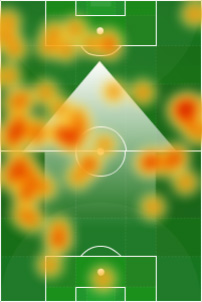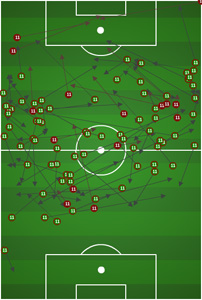Bringing Useful Stats into Soccer
Posted on Oct 14, 2012 by Trevor in Misc, Technology
Stats: A love/hate relationship
I’ve noticed a lot of people hate statistics. Especially statistics classes. But one type of stats that seems to make a lot of people happy is sports stats. Sports fanatics use them to dig deeper into the game. You can get a new insights when analyzing and analyzing teams and players. Most hardcore baseball fans know their favorite players’ batting averages, and most hardcore NBA fans know the rough points-per-game average of the league’s top scorers. It helps them feel more connected to their pastime.
 If you’ve seen the movie Moneyball, with Brad Pitt and Jonah Hill, you’ve seen how dramatically statistical analysis can change a game. Beane (Pitt) is a desperate General Manager of a baseball franchise facing a deep talent deficit and a severe lack of finances. Ruling out traditional scouting methods for finding new players, the GM entertains a theory floated by a statistics jockey named Brand (Hill): using sophisticated stats to analyze the true value of overlooked players could be a great way to buy and trade for players that significantly boost the likelihood of winning games. So Beane talks the staff into acquiring a team full of perceived underachievers who are statistically successful in certain roles. Lo and behold, the bottom-feeding team ends up setting a record for winning streak.
If you’ve seen the movie Moneyball, with Brad Pitt and Jonah Hill, you’ve seen how dramatically statistical analysis can change a game. Beane (Pitt) is a desperate General Manager of a baseball franchise facing a deep talent deficit and a severe lack of finances. Ruling out traditional scouting methods for finding new players, the GM entertains a theory floated by a statistics jockey named Brand (Hill): using sophisticated stats to analyze the true value of overlooked players could be a great way to buy and trade for players that significantly boost the likelihood of winning games. So Beane talks the staff into acquiring a team full of perceived underachievers who are statistically successful in certain roles. Lo and behold, the bottom-feeding team ends up setting a record for winning streak.
In the NBA, they have a Player Efficiency Rating (PER), which is a relatively simple formula combining a player’s statistics like shooting percentage, blocked shots, etc. and yielding a single number. Of course, one number is far from a complete story, but it is another metric for coaches, fans, scouts, and opposing players to consider when determining where a player is most effective and most vulnerable.
Sports are very diverse
Not all sports are as amenable to statistical analysis as baseball or basketball even. Go look in the sports section of your local newspaper. You’ll see a complete stats grid for the most recent MLB or NBA games, along with a simple score for the MLS games. Granted, soccer is not as popular yet, but that’s not the only reason. It’s simply a sport that’s notoriously difficult to quantify.
Does that mean we can’t gather and extract useful data? Luckily, no. It’s just harder. There are the traditional soccer statistics, such as the oft-cited “possession percentage” and “shots on goal”. Let’s look at the stats for the US Mens National Team in their World Cup qualifier match against Antigua and Barbuda.
The most notable statistic is the staggeringly lopsided possession percentage: 76% to 24%. Right off the bat one would suppose that the US walked away with an embarassingly easy victory. That was definitely not the case, however. Despite being a nation of only 82,000 people, Antigua and Barbuda almost tied a game they should’ve lost by a large goal margin. The stats show that the US was unable to convert its huge advantage in possession to shots on goal, but they probably show little beyond that. What else can a coach or a fan turn to?
Well, the MLS releases a “chalkboard” for each game played, and there’s some pretty cool stuff in it. You can find heat maps showing how much time an individual player has spent in different areas of the field, passing diagrams to see how well a team’s playmaker is distributing the ball, and lots more. Check out Real Salt Lake’s last match, versus the LA Galaxy.
Here’s a heat map showing where RSL forward Fabián Espíndola spent his time:

Here’s a diagram showing how RSL midfielder Javier Morales distributed the ball:

Is there more that can be done? Yes, there is now.
Wearable technology
Sports apparel companies are beginning to market very interesting technology for tracking even more performance data. What if you could wear accelerometers in your cleats that tracked how far you ran, when, how fast, and how intensely? What if you could wear a bracelet and respiratory monitor to track your heart and breathing rates to see how fatigued you were, how fit you were, and how efficient you were? Enter Nike+ and adidas miCoach.
Here’s an example of the data you can gather from this kind of tech:

Now what if statistical analysis in soccer further develops to the point where sophisticated algorithms combine data from GPS measurements, accelerometers, heart rate, breathing rate, and play classification? What if we added in the complicated logistics analysis used by companies like UPS and started compiling detailed information on the exact types of successes and failures each team and each player has? As an IT guy, it’s fun to consider just what this would look like.
Side Notes
Beyond sports statistics, I think this technology would be very useful for taking care of infants, the elderly, or the disabled. If babies could wear a simple, inexpensive breathing monitor that sent data to a smart phone or tablet, we could pretty much eliminate the risk of SIDS. If grandpa suffered from heart problems, it would be great to get notifications of any issues on his caretaker’s smart phone.

